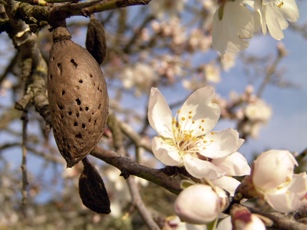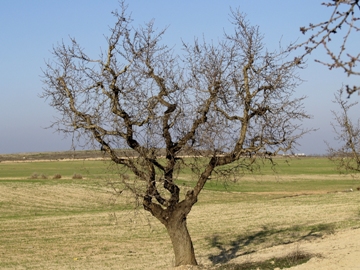Interactions

Prunus dulcis is a source of food for many. It is a primary producer, meaning it makes its own food, and the fruit of the tree is consumed by various mammals and birds. The trees also have many heavily pollinated flowers which attract pollinating insects to them as well. Almond orchards are common in California and are utilized by many humans. Not only are humans able to eat almonds and obtain a nutritional value, many make a living off of harvesting almonds.
Almond trees are in danger of diseases caused by
parasitic relationships with fungi. Some of the
most common interactions with fungi are:
-Brown Rot: This disease is when a
fungus, Monilinia laxa, form conidia on the tree which
create cankers that infect the shoots and blossoms of the
Prunus dulcis tree.
-Shot Hole: This disease is when a
fungus, Wilsonomyces carpophilus, infects the leaves as
they emerge from the bud, creating lesions on the leaves and
fruit. This leads to defoliation and causes the young fruit to
drop.
-Scab: This disease is caused by the
fungus, Cladosporium carpophilum, which creates greasy
black spots on the leaves and can cause a whole almond tree to
defoliate in a short time.
-Anthracnose: This disease is caused by
the fungus, Colletotrichum gloeosporioides, which creates
deep lesions on the fruit, the wood, and the leaves.
Mychorrihzal fungi: This fungus is causes
a positive impact on the tree. This fungus exchanges
nutrients such as nitrogen, phosphorous, and water with the
plant.
A few other negative, disease related relationships with the
almond tree are: Witches Broom, Conks, Crown Galls, Nematode
Lesions, and Root Knots.
Nematode lesions: This is caused by the
parasite, Pratylenchus, which
eats the end of the trees roots and produce lesions causing
obstruction of the flow of nutrients through that root.
Root Knots: This is caused by the
parasite, Meloidogyne,
which feed on the root causing it to swell and create
a knot like structure causing the root to be stunted.
Crown Gall: This is caused by the
bacteria, Agrobacterium tumefaciens, which grow large
structures at where the root meets the stem which can cause the
plant to be stunted in growth.
Almost an almond expert! It has all been interesting but learn some more interesting facts!
